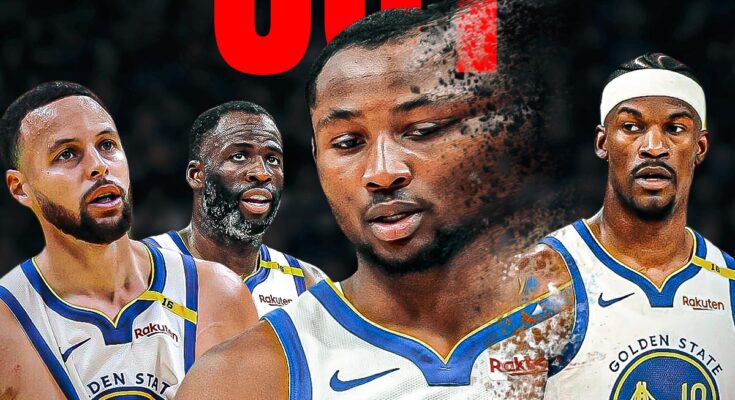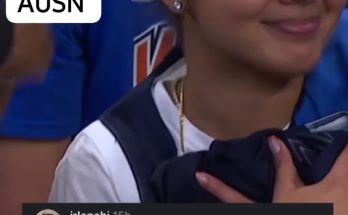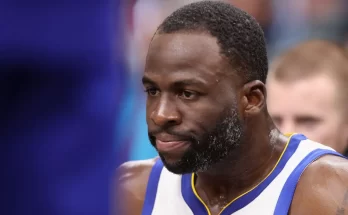The saga of Jonathan Kuminga and the Golden State Warriors has reached a pivotal crossroads, stirring both intrigue and uncertainty among fans, analysts, and the broader NBA community. What was once a promising chapter for the young forward, marked by flashes of brilliance and untapped potential, now seems to be unraveling into a complicated narrative of unmet expectations, organizational patience wearing thin, and a player seeking greener pastures elsewhere. The signs, many would argue, were there all along. From sporadic DNPs (Did Not Plays) in games the Warriors desperately needed to win, to a diminishing role after the blockbuster trade that brought in Jimmy Butler, to public expressions of frustration about constantly being told to “stay ready” but rarely seeing consistent minutes—Jonathan Kuminga’s tenure in Golden State appears to be teetering on the edge of an ending.
At just 22 years old, Kuminga has had moments where his star shone bright. The 2025 season, in particular, was a significant year for the young forward. He exploded offensively at times, putting up back-to-back 34-point games that showcased his dynamic scoring ability and athleticism. More impressively, Kuminga delivered a breakout playoff performance when the Warriors’ cornerstone, Stephen Curry, went down with injury. In that critical stretch, Kuminga stepped up to fill the void, proving he could handle the pressure and perform on basketball’s biggest stage. Yet, despite these flashes of promise, it never quite translated into a consistent, trusted role within Steve Kerr’s rotation.
The dynamics of the Warriors’ roster and coaching strategy played a huge part in this. Golden State, a team deeply rooted in veteran experience and championship pedigree, seemed to lean heavily on its seasoned players when the stakes were highest. While Kuminga showed he could contribute, Kerr’s preference for tried-and-true veterans in crunch time meant that Kuminga’s opportunities were limited, sporadic, and sometimes even nonexistent when the Warriors needed a spark. The young forward was often the odd man out, the one told to “stay ready,” to continue developing, but to sit on the bench as the team navigated must-win situations.
This dynamic created a tension that became increasingly palpable. For a young player on the cusp of his prime, minutes and trust are everything. Kuminga’s frustration was visible, both in the way he handled his limited role and in the growing distance between player and team expectations. The Warriors, on the other hand, remained patient, extending a qualifying offer that suggested they were willing to give the “Kuminga experiment” another year. However, reports now indicate that Kuminga’s camp is actively pushing for a fresh start elsewhere, seeking a lucrative contract in the realm of \$30 million annually—a substantial payday that reflects both his potential and the value his camp believes he commands.
This standoff has created a complex situation for Golden State. On one hand, they have a young player who has shown the ability to produce at a high level, particularly in moments when the team needed him most. On the other hand, the relationship seems strained, the fit uncertain, and the asking price steep—factors that have reportedly stalled trade talks. Multiple teams expressed interest in acquiring Kuminga, but the Warriors’ demands have been too high, scaring off potential suitors and leaving the organization at a crossroads. Should they hold the line, betting on Kuminga’s continued development and a breakout season that justifies their faith? Or should they accept that the experiment has run its course and move on, redirecting resources to other players or areas of need?
This situation reflects a broader challenge faced by many NBA teams navigating the delicate balance between nurturing young talent and building a cohesive, championship-ready roster. Kuminga’s case is particularly instructive because it underscores the tension between potential and opportunity, between a player’s desire for recognition and financial security, and a team’s strategic priorities and long-term vision. The Warriors, a franchise renowned for its ability to maximize the talents of key players and build around a core of experienced veterans, now must decide if Kuminga is a part of that core or an asset better utilized in a trade.
The timing is also significant. The Warriors have been in a transitional phase over the past few seasons, juggling the challenge of maintaining championship competitiveness while integrating younger pieces and managing salary cap constraints. Kuminga, drafted as a high-upside forward with a unique blend of size, athleticism, and skill, was seen as a critical component of the team’s future. His development trajectory promised a new chapter for Golden State as they sought to extend their window of dominance beyond the Curry-Thompson-Durant era. Yet, as the season unfolded, it became clear that the synergy wasn’t quite there. Whether due to system fit, coaching decisions, or Kuminga’s own evolving confidence and style, the anticipated breakthrough has yet to fully materialize.
Moreover, the public dimension of this story adds layers of complexity. The narrative of a young player “pushed aside” despite flashes of brilliance resonates deeply with fans and media alike. In today’s NBA, where player empowerment and agency are front and center, Kuminga’s desire to seek a new home and a contract that reflects his worth is not only understandable—it is almost expected. The business of basketball is as much about opportunity and fit as it is about talent, and Kuminga’s camp pushing for a change signals a strategic move to align those elements more favorably.
For the Warriors, the decision to hold firm on their asking price during trade talks signals that they still see value in Kuminga, or at least in maintaining leverage. Perhaps they believe that the market will adjust, or that the player himself will reconsider once the reality of limited options sets in. Alternatively, it may be a reflection of the front office’s broader philosophy—one that emphasizes patience, internal development, and calculated risk-taking over quick fixes or panic trades. The Warriors have rarely been impulsive in managing their roster, preferring to build sustainable championship contenders rather than chase short-term solutions.
Yet, the risk of standing firm is that it could lead to a stalemate—an outcome that neither side desires. Kuminga could spend another year in a diminished role, leading to further frustration and diminished value. Conversely, the Warriors could miss out on an opportunity to recoup assets and reset their roster in a way that better fits their evolving strategy. This impasse raises critical questions about the future: Is Kuminga’s ceiling high enough to justify the patience? Can the Warriors find a way to integrate him more effectively into their system, or is the mismatch simply too great? And from Kuminga’s perspective, is staying in Golden State worth the uncertainty, or is a fresh start elsewhere the best path forward?
Looking ahead, the potential outcomes hinge on several factors. If the Warriors decide to hold the line and bring Kuminga back for another season, it will require a recommitment to developing the young forward, carving out a role that leverages his strengths and builds confidence. This could mean more playing time, a revamped role within Kerr’s system, or even a shift in team philosophy to prioritize youth and athleticism more heavily. On the other hand, if a trade materializes—whether now or in the offseason—the receiving team will inherit a player with tantalizing upside but with a recent history of inconsistency and underutilization. They will need to believe they can unlock Kuminga’s potential better than Golden State has.
For the NBA landscape more broadly, Kuminga’s situation is emblematic of the challenges young players face in the league. The jump from prospect to consistent contributor is steep, especially on teams with championship aspirations and deep veteran rosters. It’s a delicate balance of patience, opportunity, and timing. Kuminga’s career trajectory will be closely watched as a case study in how young talent is managed and valued in the modern NBA era.
Ultimately, the Kuminga experiment in the Bay Area may be at a tipping point. What began with high hopes and glimpses of stardom now teeters between continuation and conclusion. The Warriors’ patience and strategy, Kuminga’s ambitions and demands, and the dynamics of the league’s trade market will all play pivotal roles in determining the next chapter. Whether this is the end of Kuminga’s time in Golden State or the start of a renewed partnership, one thing is clear: the story is far from over, and the stakes could not be higher for both player and franchise. The coming weeks and months will reveal if the Warriors hold the line once more or if they finally move on, closing the door on one of their most intriguing and complicated young talents.



